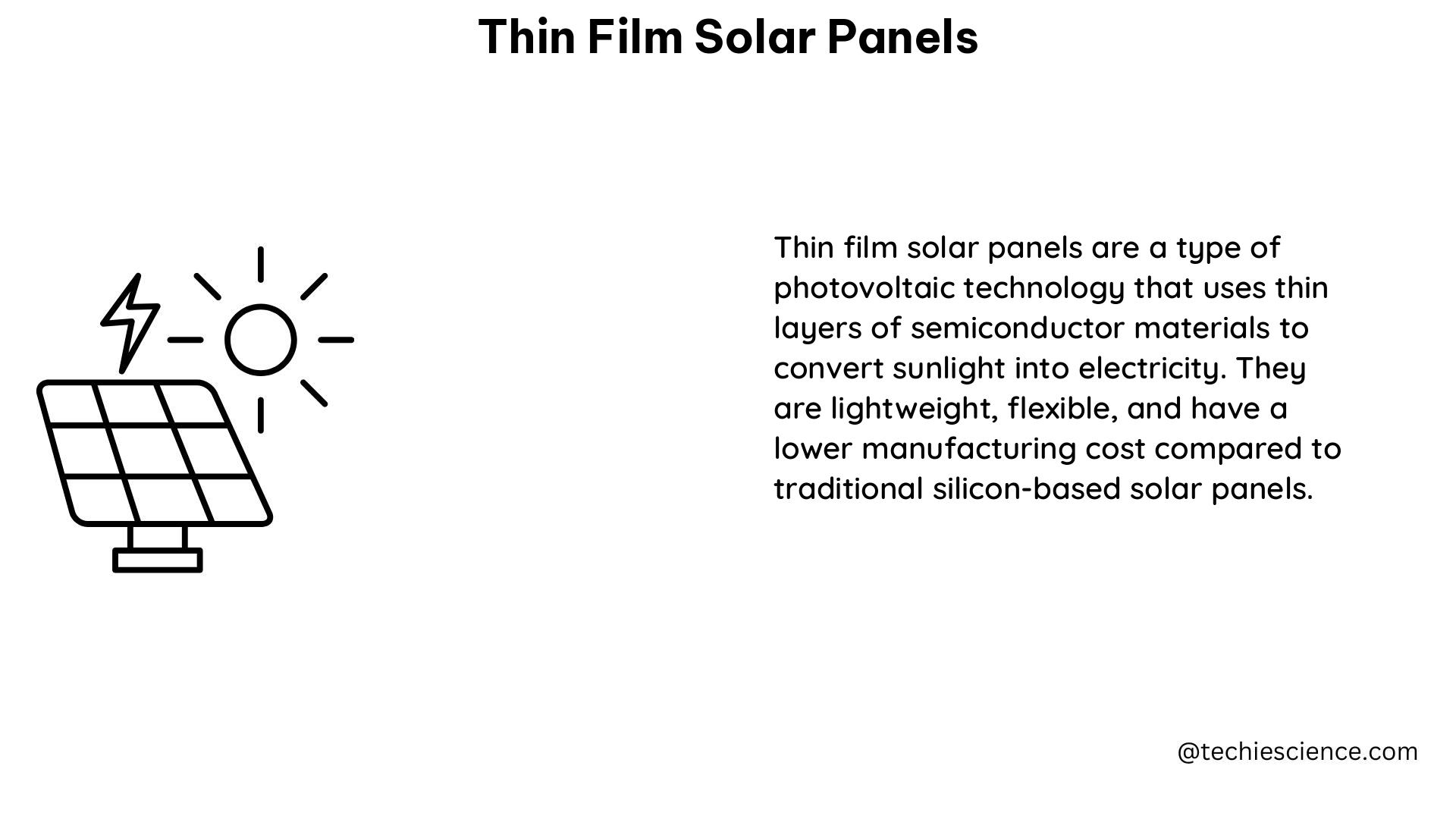Thin film solar panels have emerged as a promising alternative to traditional silicon-based solar panels, offering unique advantages in terms of flexibility, scalability, and performance under adverse weather conditions. These panels are characterized by their thin active layers, typically less than 10 micrometers thick, which enable lower material costs and enhanced versatility.
Materials and Efficiency
Thin film solar panels are primarily composed of four main materials: amorphous silicon (a-Si), cadmium telluride (CdTe), copper indium gallium selenide (CIGS), and copper indium diselenide (CIS). Each of these materials has its own set of properties, advantages, and challenges.
| Material | Efficiency Range | Advantages | Challenges |
|---|---|---|---|
| Amorphous Silicon (a-Si) | 7% to 10% | Good performance in low-light conditions, flexible | Lower efficiency, degradation over time |
| Cadmium Telluride (CdTe) | 16% to 22.1% | High efficiency, low cost, stable performance | Toxicity concerns, limited availability of tellurium |
| Copper Indium Gallium Selenide (CIGS) | 15% to 22.3% | High efficiency, flexible, stable performance | Complex manufacturing process, availability of raw materials |
| Copper Indium Diselenide (CIS) | 14% to 19.2% | High efficiency, flexible, stable performance | Complex manufacturing process, availability of raw materials |
While thin film solar panels typically have lower efficiencies than traditional silicon-based panels, ranging from 7% to 13%, ongoing research and development efforts have led to significant improvements. Laboratory-scale CIGS and CdTe thin film solar panels have achieved efficiencies of up to 22.3% and 21.7%, respectively, demonstrating the potential for further advancements.
Thickness and Flexibility

The “thin” in thin film solar panels refers to their remarkably thin active layers, usually less than 10 micrometers. This thin profile is a key factor in their lower material costs and enhanced flexibility. The thin active layer allows for the use of less semiconductor material, reducing the overall cost of production.
Thin film solar panels can be made flexible, enabling their use in a wide range of applications, such as curved surfaces, portable devices, and building-integrated photovoltaics (BIPV). This flexibility is achieved through the use of lightweight, thin-film materials and specialized manufacturing processes, such as sputtering, evaporation, and electroplating.
Manufacturing and Scalability
Thin film solar panels are manufactured using various deposition techniques, including sputtering, evaporation, and electroplating. These techniques enable large-scale production and lower production costs compared to traditional solar panel manufacturing processes.
The scalability of thin film solar panels is a significant advantage, as their coating technologies allow for seamless integration into building materials and structures. This makes them well-suited for large-scale deployment and integration into the built environment, contributing to the growth of the solar energy industry.
Stability and Performance under Adverse Conditions
Thin film solar panels have had a mixed track record when it comes to outdoor stability and performance. Some materials, such as copper sulfide, have suffered from electrochemical instability, leading to degradation over time.
However, newer materials, such as CdTe and CIGS, have shown promising long-term stability. These panels have demonstrated resilience to adverse weather conditions, including low light, high temperatures, and partial shading. Amorphous silicon and CIGS thin film solar panels, in particular, have exhibited excellent performance under these challenging conditions.
Ongoing Research and Development
Researchers and manufacturers are continuously working to address the challenges and limitations of thin film solar panels. Efforts are focused on improving their efficiency, stability, and cost-effectiveness to make them more competitive with traditional silicon-based solar panels.
Some of the key areas of research and development include:
-
Efficiency Optimization: Exploring new materials and device structures to achieve higher conversion efficiencies, with the goal of reaching parity with or exceeding the performance of traditional solar panels.
-
Stability Enhancement: Developing more stable and durable thin film materials and device architectures to ensure long-term reliability and performance in outdoor environments.
-
Manufacturing Process Improvements: Refining deposition techniques and scaling up production to reduce manufacturing costs and increase the availability of thin film solar panels.
-
Sustainability and Environmental Impact: Addressing concerns related to the use of potentially toxic materials, such as cadmium, and exploring more environmentally friendly alternatives.
-
Integration and Applications: Advancing the integration of thin film solar panels into building materials, transportation, and other novel applications to expand their market reach and impact.
As the research and development efforts continue, thin film solar panels are poised to play an increasingly important role in the global transition to renewable energy sources, offering unique advantages and contributing to a more sustainable future.
References
- Bae, D. (2023). A statistical approach to scaling up of CIGS PV cells: Quantitative analysis of composition uniformity within and between the samples. ScienceDirect.
- Taraba, M., Adamec, J., Danko, M., Drgona, P., & Urica, T. (2019). Properties measurement of the thin film solar panels under adverse weather conditions. ScienceDirect.
- How Is Solar Panel Efficiency Measured? (2023). eepower.com.
- What Do We Know About Thin Film Solar Cells? (2022). AZoM.
- Thin Film Photovoltaics (1999). NREL.

The lambdageeks.com Core SME Team is a group of experienced subject matter experts from diverse scientific and technical fields including Physics, Chemistry, Technology,Electronics & Electrical Engineering, Automotive, Mechanical Engineering. Our team collaborates to create high-quality, well-researched articles on a wide range of science and technology topics for the lambdageeks.com website.
All Our Senior SME are having more than 7 Years of experience in the respective fields . They are either Working Industry Professionals or assocaited With different Universities. Refer Our Authors Page to get to know About our Core SMEs.